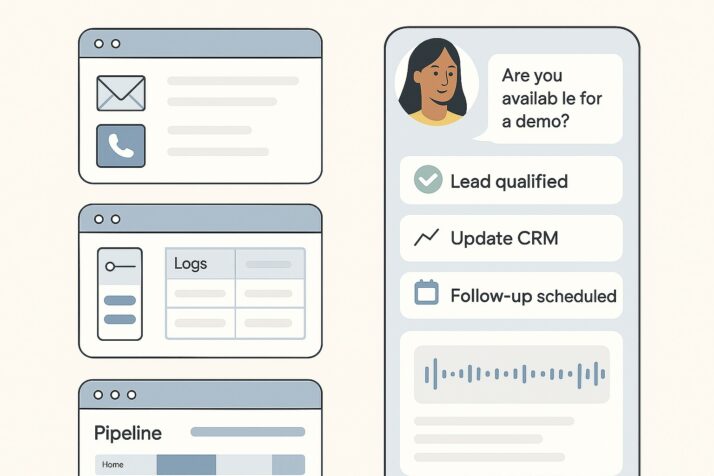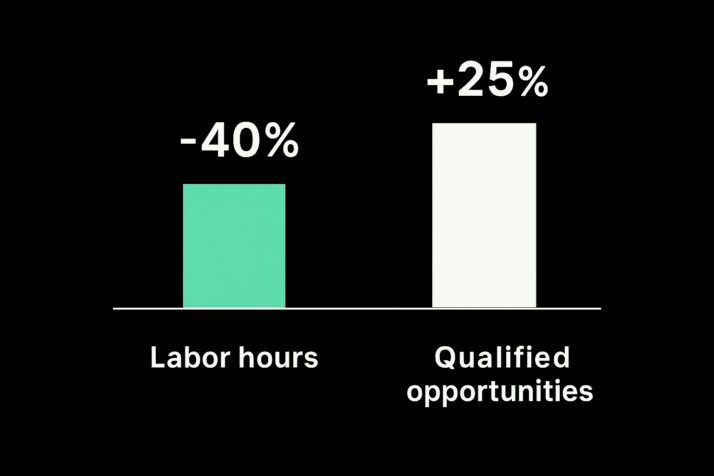Once tucked away in back-office systems or tinkered with in free ChatGPT chats, AI has taken center stage. And it’s not just about streamlining workflows. AI is actively helping companies uncover patterns, predict behaviors, and close deals.
What started as simple number-crunching has evolved into digital agents supporting sales processes and e-commerce. What are AI Sales Agents, and how do they affect sales?
What are AI Sales Agents?
AI sales agents are autonomous digital workers built to collaborate with human teams. They scan sales and customer data, spot patterns, and act without needing constant direction. These systems know when to follow up with a cold lead, update your CRM, or send a tailored email using natural language tools and decision logic.
Think of them as tireless SDRs or sales ops teammates. Sales agents take on the manual tasks, data entry, lead tracking, handoffs, and handle them with speed and precision.
What once required hours of clicking, copying, and coordinating now runs on autopilot.
Sales teams once stitched together tools. One for tracking leads, another for managing workflows, and another for pulling reports. But gone are those days.
How Do AI Sales Agents Differ from Traditional Sales Tools?
Traditional sales technologies like rule-based lead scoring depend heavily on predefined workflows and constant human intervention. In contrast, AI sales agents are different. Besides these, other notable differences include:
Intelligence That Grows With Every Interaction
Traditional software runs on static rules: If X, then do Y. But AI sales agents operate differently. They use machine learning and natural language processing to understand intent, assess context, and make decisions in the moment.
For instance, if a prospect hesitates on a pricing page, an AI agent can pause outreach or pivot the messaging. Or if someone clicks through multiple product features, the agent might immediately follow up with a tailored demo invite.
The best part is that no human prompting is required.
This adaptive intelligence means performance improves over time. Every reply, every campaign, every deal teaches the system what works and what doesn’t. In retail, companies like Carrefour have used AI to personalize customer messages at scale, driving a fourfold increase in click-through rates.
End-to-End Execution Without the Hand-Offs
Older systems were fragmented. One tool sends emails; another logs calls. While another tracks pipeline movement. And handoffs were manual and slow. AI agents change that by orchestrating the entire process from the first contact to closing the deal.
How?
They start conversations, qualify leads, update CRMs, and schedule follow-ups, all in one flow. No tab-switching or follow-up reminders. Some agents can even analyze sales call recordings in real time, identify objections, summarize key moments, and involve people in edge conditions or key decision points.

Seamless Integration
Most traditional sales tools integrate poorly, if at all. AI agents are built to work across systems. They plug into CRMs, marketing platforms, chat tools, and analytics engines. This native AI agent integration allows agents to respond fluidly across channels.
An AI sales agent will stitch together buyer signals from multiple sources like web clicks, email opens, and voice calls into one cohesive sales strategy. In insurance, agents assist live reps during calls, suggesting better phrasing or timing offers in real time. As expected, this leads to noticeable boosts in close rates.
Proactive by Design
Perhaps the most profound difference is behavioral. Traditional tools are passive; they wait. AI agents are more proactive as they initiate.
When a new lead arrives, old systems send a form response and wait for a rep to follow up. On the flip side, reach out immediately, tailor their message, and begin a real conversation. They do it without breaks, without drop-offs, and without losing the thread.
Scaling Revenue Operations Without Linear Headcount Growth
Without an AI sales agent, more leads mean more hires. Growth requires bodies. For instance, SDRs need to follow up, analysts track results, and managers coordinate it all.
With automation, teams can expand their reach without expanding their payroll. Agents take over the high-volume, low-judgment work all in real time and without ever clocking out. The payoff here is leaner sales teams that can do more, faster.
In essence, AI sales agents allow companies to:
- Deploy 24/7 engagement workflows that never miss a prospect interaction, no matter the time zone or hour.
- Enter new markets or segments quickly, without needing to staff up first.
- Reallocate budget from manual labor to higher-leverage initiatives, tools, and strategy.
By handling scale without requiring parallel headcount growth, AI agents give RevOps leaders something rare: growth with predictability.
Why Timing Still Closes Deals
In sales, timing is everything. AI sales agents close the gap between signal and response, turning missed opportunities into booked meetings. They react immediately to digital triggers: a clicked link, a downloaded white paper, or a product page visit, and follow up within seconds without delays.
That means:
- Instant responses to engagement triggers: Whether a prospect opens an email or submits a form, the sales agent can respond automatically to schedule meetings, send tailored messages, and even research the contact.
- Seamless handoffs to sales reps: They eliminate manual update lag by logging activities, enriching CRM records, and notifying the right person at the right moment.
The result is faster conversions, shorter sales cycles, and more closed deals all without overloading the team.
Real-World Impact: SmythOS AI Sales Agents
At SmythOS, AI sales agents are live, active members of the sales team. The platform deploys these agents to run multi-step campaigns that combine email outreach, in-app messaging, and SDR call scheduling into one fluid system.
Each agent monitors campaign performance as it unfolds. So, they track opens, clicks, replies, drop-off points, and adjust the messaging or timing as needed. A prospect who engages early might receive a faster handoff to an SDR. One who hesitates could get a follow-up tailored to their behavior. The goal is simple: relevance.
And the numbers show it. SmythOS clients report reducing labor hours by as much as 40% while increasing qualified opportunities by 25% within the first 90 days of deployment. When you automate the rote work and optimize campaigns on the fly, teams spend less time chasing and more time closing.

Integration Across CRM, Marketing Automation, and Sales Enablement
Smooth integration is key to how it all works. SmythOS agents connect natively with systems like Salesforce, HubSpot, Marketo, and Outreach.
That means data flows automatically between marketing, sales, and ops without uploading files or manual syncs. Teams get a shared view of every lead, every touch, and every outcome. And the AI? It takes care of the rest.
AI Sales Agents: Reforming the Future of Sales
As competition stiffens and customer expectations rise, speed and precision in sales are non-negotiable. Companies that deploy AI sales agents are pulling ahead by doing more with less. Of course, that means faster pipelines, sharper targeting, and teams that can focus on what humans do best: building relationships.
For revenue leaders, the path forward starts with clarity. Begin with a single use case. Pinpoint the bottlenecks, like the low-value tasks that drain time but don’t require judgment.
Afterward, set clear metrics and let the agents prove themselves.
The smartest teams test the agents before rolling out everything. They measure and iterate. AI systems, after all, learn. So should the organizations using them. Once the gains are visible, whether in lead response times, meeting volumes, or conversion rates, scaling becomes a matter of confidence. In sales, every advantage counts, and an AI sales agent gives you a head start. So, the question is how fast you can put them to work?
